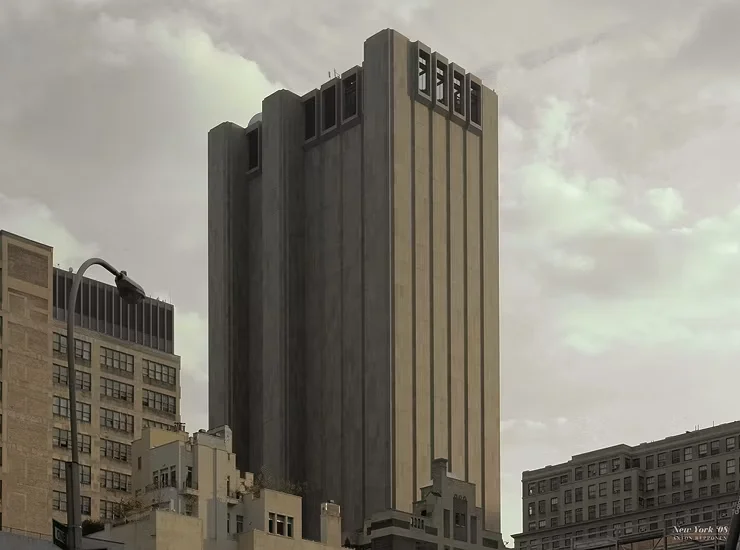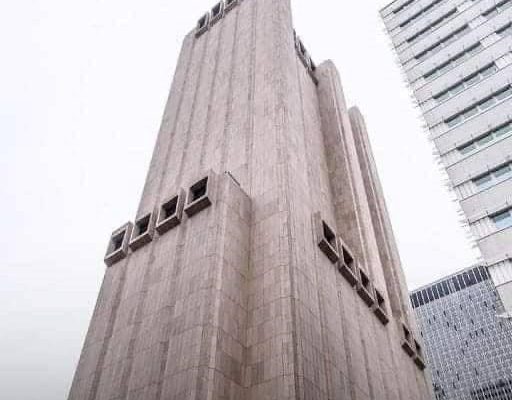In Lower Manhattan, there’s a peculiar and imposing structure known as the “Long Lines Building” at 33 Thomas Street. This 29-story skyscraper, commonly referred to as Titanpointe, stands out not just for its height but also for its distinct lack of windows. For years, it has intrigued New Yorkers with its fortress-like design and mysterious purpose.
Constructed in 1974, the building was designed to withstand atomic blasts, reflecting the Cold War anxieties of the time. The architectural firm John Carl Warnecke & Associates created it as a telecommunications hub, intended to protect critical communication equipment from potential nuclear threats. Rising 550 feet into the New York City skyline, the tower’s concrete and granite exterior makes it look like something straight out of a dystopian movie. Unlike surrounding office buildings and apartments, it remains perpetually dark, adding an eerie touch, especially at night. The soft hum from its square vents, often drowned out by the city’s hustle and bustle, only deepens its aura of secrecy.

For decades, the true function of this building was shrouded in mystery. While officially known as a secure telecommunications center, new evidence suggests it served a far more secretive role. Leaked documents from Edward Snowden, combined with architectural plans and interviews with former AT&T employees, reveal that 33 Thomas Street may have been a significant surveillance site for the National Security Agency (NSA), codenamed Titanpointe.
The revelations indicate that the building houses an international gateway switch, a crucial hub for routing phone calls between the U.S. and other countries. It’s believed that the NSA has been intercepting these communications from within the heavily guarded confines of this AT&T-owned building. Allegedly, the surveillance program targeted not only international organizations like the United Nations and the World Bank but also allied countries, blurring the lines between foreign surveillance and domestic privacy.
While AT&T’s cooperation with the NSA has been documented extensively, the precise role of 33 Thomas Street remains murky. The Snowden files reveal that NSA equipment is integrated into AT&T’s systems, allowing data collection directly from the company’s network in New York City. Yet, it’s unclear whether the NSA directly accessed AT&T’s resources at this particular location or simply leveraged the company’s broader infrastructure for surveillance purposes.
Elizabeth Goitein, co-director of the Liberty and National Security Program at the Brennan Center for Justice, emphasized the implications of this secretive partnership. “This is yet more proof that our communications providers have become, whether knowingly or not, an extension of the surveillance state,” she noted. The deep ties between the NSA and private telecommunications companies raise concerns about the boundaries of surveillance and whether the privacy of American citizens is truly safeguarded.
Further reports from The New York Times and ProPublica in August 2015 confirmed AT&T’s extensive collaboration with the NSA, with the company praised for its cooperation. However, despite these revelations, Snowden’s files did not definitively confirm that the NSA was actively using AT&T’s facilities at 33 Thomas Street. While AT&T controls most of the building, some of the space is also owned by Verizon, adding another layer of complexity to the surveillance puzzle.
The presence of NSA operations at 33 Thomas Street raises significant legal and ethical questions. This building, looming large in the heart of New York City, serves as a stark reminder of the delicate balance between privacy and security in our increasingly digital world. As surveillance technology advances, so do the challenges of maintaining oversight and protecting citizens’ rights.
In conclusion, 33 Thomas Street is more than just a telecommunications landmark—it’s a symbol of the complex and often hidden relationship between government surveillance and public privacy. While its true role in government spying may never be fully uncovered, it continues to stand as a testament to the tension between security measures and civil liberties in the modern age.



